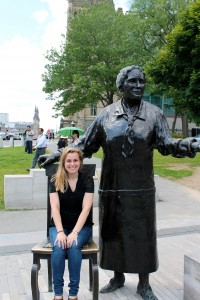In order to tell us the story of a stereo salesman, Lionel Red Deer (whose past mistakes continue to live on in his present), a high school teacher, Alberta Frank (who wants to have a child free of the hassle of wedlock—or even, apparently, the hassle of heterosex!), and a retired professor, Eli Stands Alone (who wants to stop a dam from flooding his homeland), King must go back to the beginning of creation. Why do you think this is so?
King’s novel begins with a feeling of disjointedness between the sections with the four Indians and the sections with other characters. That disjointedness comes from the distinction between the ancient stories the four Indians are telling, and the recognizably modern lives lived by characters like Alberta, Lionel, and Eli. At first, it was not even clear to me that the four Indians were in the same time period as the others. As the novel goes on, the two worlds start to merge as the reader realizes that Coyote, Ishmael, Robinson Crusoe, and Lone Ranger are the same four Indians who went missing from Hovaugh’s hospital in the beginning. Then the four Indians meet Lionel on the road, bringing their presence directly into the other characters’ lives. I can’t speak to whether this was King’s intention, but for me it brought the mysticism of ancient Indigenous stories together with the modern perspective.
King begins the novel with “So. In the beginning, there was nothing. Just the water” (1). I believe that King’s emphasis throughout the novel on creation stories, of both Indigenous and Christian descent, is a way of showing their importance to human beings on an essential human level. In a personal sense, King has a connection with both these cultures as his mother is of Greek descent and his father Cherokee. Perhaps his emphasis on blending and in doing so critiquing creation myths comes from their importance in his own life and personal history. Regardless, I think that King shows he importance of these stories to his characters through their attempts to leave the reserve and eventual return to it.
This is most prominent in the story of Eli Stands Alone. He has lived apart from the reserve for most of his adult life, yet he returns when his girlfriend, Karen, dies in a car accident. Upon his return, he discovers that his mother’s cabin is going to be torn down to make way for a dam. He protests this, and lives in the cabin until his death. What this story says to me is that even though Eli wanted to start a new life away from the Blackfoot and their traditions, he ultimately had a love of it deep enough to defend his family’s right to their land. To me, this was the first inkling of what I believe King is trying to get across: that no matter whether we believe in them in a literal sense, our myths and traditions are a part of who we are as individuals.
In the case of Alberta, she has also lived away from the reserve for most of her adult life. Alberta teaches in Calgary, and only comes to visit when she is seeing one of her lovers, Lionel. Lionel’s birthday is what brings her back home in the novel. Although Alberta seems to engage with her culture again almost accidentally (she runs into Latisha who prods her into going to the Sun Dance that day), she ends the novel as an active participant in that culture. When we last see Alberta, she is pregnant thanks to one of Coyote’s tricks, and she is helping Norma and Latisha rebuild Eli’s mother’s cabin after the dam washed it away. Here again, an Indigenous character returns home only to find what she had been looking for everywhere else.
Lionel is an exceptional character in that he does not live off the reserve, but he does work off the reserve. Lionel works at Bill Bursum’s selling televisions. Bill Bursum is clearly racist against Indigenous people. Although he has no problem hiring them as he does for Lionel and Charlie, Bill’s dialogue and thoughts show that he believes himself to be inherently better than them. This is emphasized at his extreme anger over the Western he watches on the Map having the ending changed so that John Wayne is killed by the Indians instead of vice versa. By engaging with Bill’s world, Lionel shows a distancing from his own culture and an implicit shame of his people. Furthermore, Lionel hopes to go to university and start a new life outside of the reserve like Eli. While Lionel does not actually desert the reserve, the reason why seems to be more about his inability to get things done, than about a desire to remain true to his heritage. Reluctantly, we see Lionel also join Latisha, Norma, and Alberta in helping to rebuild the cabin at the end. He says he even might live in it for a while, although Norma is quick to tell him, no luck, she has first dibs. For a character like Lionel – who I think is best described as a person who lets things happen to him – creation myths are perhaps of the most importance in that they actively affect him and his lifestyle. No matter Lionel’s intentions, he can’t seem to get away from his heritage.
–
Works Cited
“Blackfoot Confederacy.” Canadian Encyclopedia. Historic Canada, n.d. Web. 26 Apr. 2016.
Cherokee Nation. Cherokee Nation, 2016. Web. 26 Apr. 2016.
King, Thomas. Green Grass, Running Water. Toronto: HarperCollins, 1993. Print.
Schaffer, Jennifer. “21 Feelings All Mixed-Race People Know.” BuzzFeed. BuzzFeed, 13 Oct. 2014. Web. 26 Apr. 2016.


